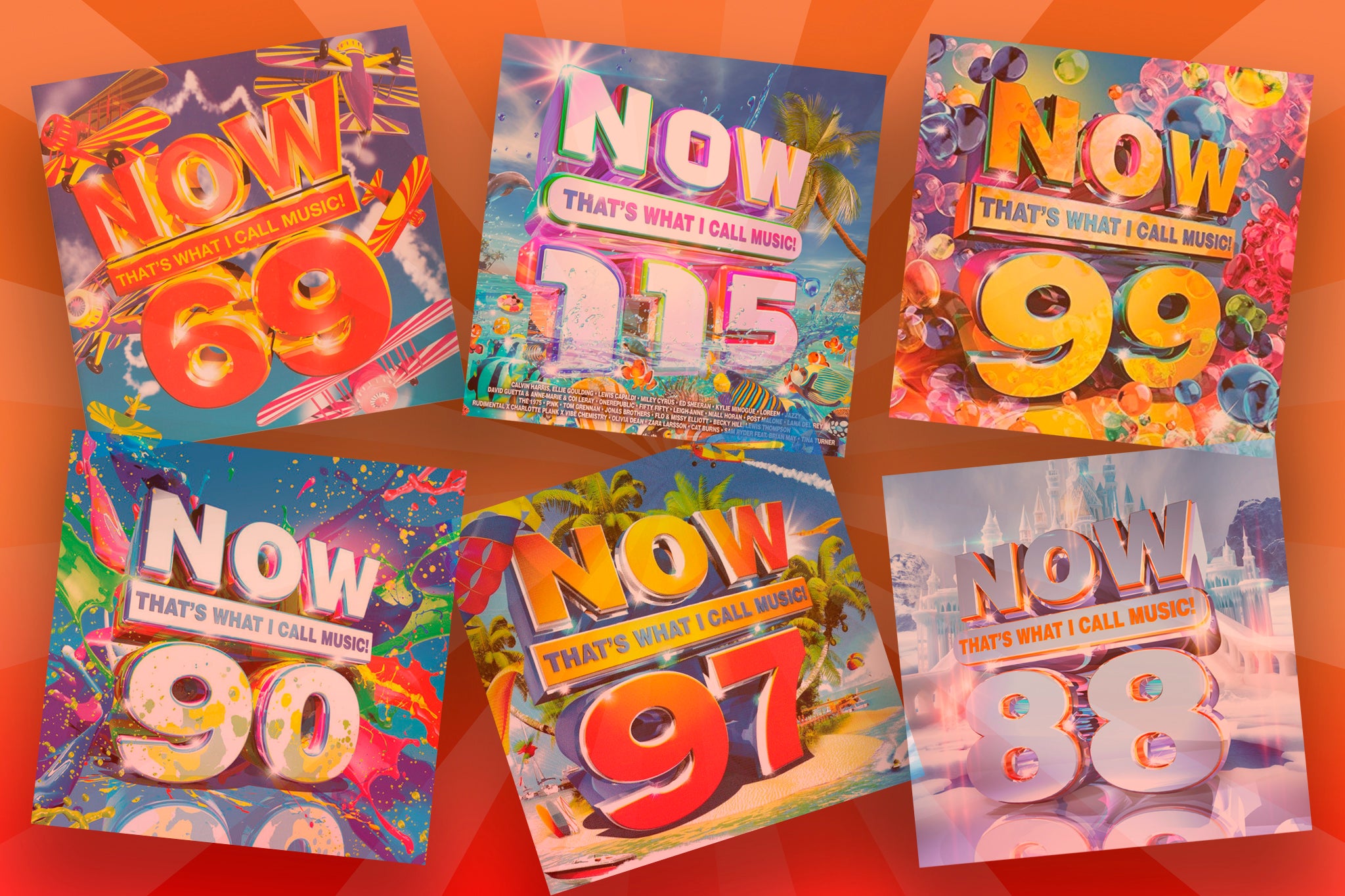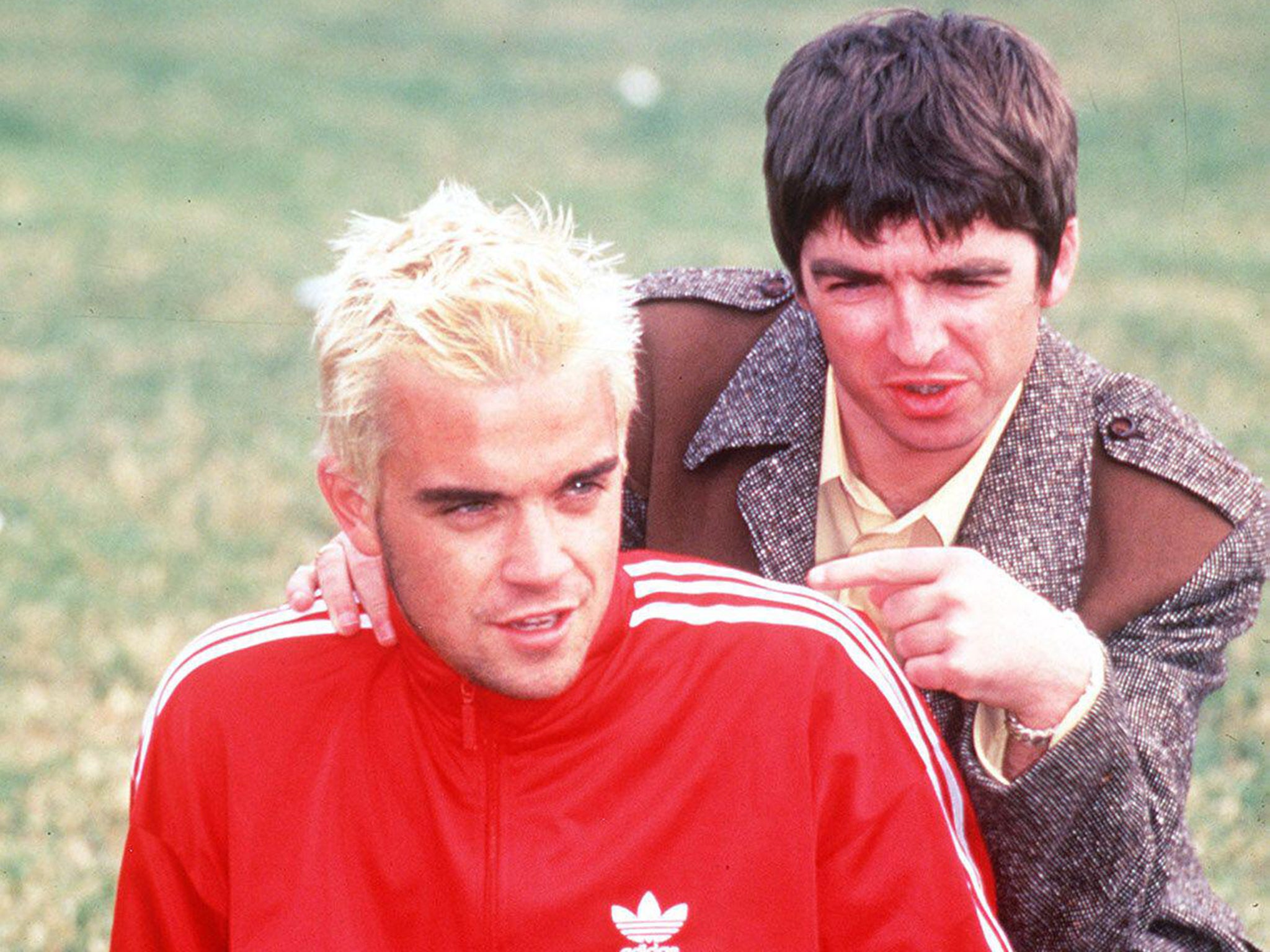‘Where else can you hear Bob the Builder singing Mambo No 5?’ The bizarre legacy of Now That’s What I Call Music!
For decades, Virgin Records’ Now compilation albums have been preserving in aspic the music trends of the past. To celebrate its 40th birthday, Michael Hann speaks to the executives who dreamt it up and its die-hard devotees about the series’ legendary origin story and its wacky journey

If you want to trace the history of pop over the past 40 years, don’t bother with books. Don’t look at lists of greatest albums. Don’t listen to earnest critics agonising over whether My Bloody Valentine were more influential than Public Enemy, or trying to parse the real meaning of Taylor Swift’s Instagram posts. Just pick up some compilation albums. Specifically, some copies of Now That’s What I Call Music! – the long-running, bestselling music series that released its first album on 28 November 1983.
The stats are staggering. Its 116 volumes sold so far are more than the total career sales of Abba, Fleetwood Mac, Phil Collins or the Bee Gees, and 113 of them have reached No 1, spending a total of 771 weeks – nearly 15 years – at the top of the charts. The albums have featured 2,409 different artists and 675 No 1 singles.
There are artists for whom Now has become a second home: Robbie Williams has appeared 38 times; 32 as a solo artist and six as a member of Take That. There are artists who featured on Now in its early stages, never to reappear – such as Will Powers, whose “Kissing with Confidence” was track 25 of the first ever edition in 1983. And there are those artists who simply can’t be banished, like The Rolling Stones, whose “Undercover of the Night” featured on 1984’s Now 2 and whose latest single “Angry” appears on this year’s Now 116.

Now has fans everywhere, sometimes in the most unlikely places. “Put on a Now album and it can transport you to the summer after you did your A-levels, or the time you met your wife,” says Jonathan Isaby, who – when he isn’t collecting every edition of the series – works as press secretary to Liz Truss. “Each album is a snapshot of a particular few months in history. These albums are, literally, the soundtrack to my life.”
For Martyn Young, presenter of the Chart Attack podcast, Now is as much a social history as it is a series of albums. He notes that you can trace trends through editions of Now in a way you can’t anywhere else: “It captures time periods – like the UK garage period from late 1999 through to 2001, and a lot of forgotten UK garage hits crop up on the Now albums from that era. You can see these threads where trends rise and when they peter out: the last big garage hit is on Now 49: ‘Do You Really Like It?’ by DJ Pied Piper.”
All of this is an accident, of course. Now was never intended to be an ongoing documentary about pop music, or a way of preserving in aspic the trends of the past – after all, the word “Now” captures the thing each album is supposed to represent: the moment. Its remit has always been very clear: hits, hits, hits. This means no filler; no extreme music; and no over-the-top silliness. Heavy metal has seldom had a look-in (even during Iron Maiden’s chart-topping heyday) and while there has been the odd novelty song here and there, they are rare. “These were records that were being sold to play at parties, and you didn’t want people to have to take them off,” says Jon Webster, who, as head of marketing at Virgin Records in 1983, was one of the two people credited with inventing the series.
Webster hadn’t intended Now to be a series. It was born as a one-off, to be launched in time for Christmas 1983, for the simple reason that Webster’s fellow Virgin executive Stephen Navin was certain the company could make more money from compilation albums if instead of giving tracks to the cheap and cheerful companies that dominated the sector at the time, such as K-Tel (sample titles: Hit Machine, Action Trax) and Ronco (Chartbusters 82, Breakout: 22 Roaring Great Hits!), they released it themselves.
At the time, Virgin was enjoying a sparkling run of success in the singles charts: its roster included Phil Collins, Culture Club, Human League, OMD, Simple Minds, and Japan, as well as other less likely hitmakers such as Mike Oldfield and PiL. “That period – 1982 and 1983 – was incredibly successful for Virgin, and we were licensing a lot of tracks for substantial amounts of money,” says Navin, who, as head of legal and business affairs, had been responsible for licensing tracks to those K-Tel and Ronco compilations. “It occurred to me that we were in this wonderful situation and the middleman profit could be taken by Virgin.” As starry as its roster was, however, the label couldn’t put together a 30-track compilation on its own, so it was decided to bring EMI – which distributed Virgin’s records in the UK – in as a partner.

The whole enterprise was a magnificent piece of British ingenuity: it took just two months from Webster’s first meeting with EMI to the first Now album hitting shop shelves. Even the title was a happy accident, taken from a poster Navin saw in the office of Virgin MD Simon Draper. “He had a little 1930s cartoon published by the Danish bacon marketing board, and the line on it was, ‘Now that’s what I call music.’ I immediately said, ‘Wow, there you go. Let’s call it that.’ It was extraordinarily pertinent.”
The first Now album was launched with a £250,000 TV advertising budget (the equivalent of more than £800,000 today). Its first ad was voiced by comedian Tracey Ullman (whose cover of Kirsty McColl’s “They Don’t Know” appeared on the album) and the second by DJ Gary Crowley in his geezer-next-door cockney accent. “Now That’s What I Call Music!, that’s the name of the album, right? And it’s 30 of the year’s faberooniest hits! It’s fantastic, OK?” offered Ullman, in a voice that traversed ordinary bloke, portentous trailer parody and chirpy girl next door in the space of 30 seconds. Meanwhile, Crowley played less for comedy, more for information: “A double album or cassette in the record departments of Woolworth’s, Tesco, Martin.” The ads worked. Webster says Now sold a million copies within a month of release. Back at the office, senior management had just one message for him: “We can’t stop now.” And just like that, a brand was born.
Now fans have their own particular favourites from the series. Rather like albums by The Fall, or editions of NME, Now always seems to have been best in that first flush of discovery. Love of a particular Now edition is rarely dependent on the quality of the music therein. “I still love Now 10 because it was the first one I bought and it has a special place in my heart,” Jonathan Isaby says. “Now 67 I’m very fond of, because it came out when I met my wife, and we spent many car journeys listening to it. For the mid-thirties albums, I was at university and listening to those transports me back to special moments with friends.”
“I have a fondness for Now 7,” says Iain McDermott, host of the Back to NOW! podcast. “I think 1986 gets a raw deal when people look at the Eighties – it was post-Live Aid, at the start of the cynical CD age, and the dash of the early Eighties had gone. But I was 13, there was a lot going on and the Eighties were finding their feet – and it’s got a wonderful cover of an Eighties shopping bag. The memory I would associate it with would be that opening up of the gatefold sleeve, and of seeing the ad in Smash Hits – in the days before social media the way to find the tracklist for the latest Now was to see the Smash Hits ad the week before. That edition had ‘Opportunities’ by Pet Shop Boys and – becoming slightly geeky – it’s a specific remix that wasn’t available anywhere else, though we didn’t know that at the time.”
Back to NOW!, McDermott says, is all about those memories. Guests talk about their favourite album, and why they love it so much. “The response to the first few editions was that everyone had a favourite, regardless of their age, and they had a story to tell about it. That resonated with listeners because everyone has those stories,” he says. “And the sequencing of their favourite album is something everyone can remember – they all say that when they hear one song that appeared on the album, they expect to hear whatever followed it on Now next.”
Martyn Young says Now albums allow one to appreciate songs that in any other context might sound horrific. “It’s things like Bob the Builder’s version of ‘Mambo No 5’ [which appeared on Now 50],” he says, laughing. “I am never going to actually choose to listen to that, but when it comes up in the context of a classic Now album, I find I’m actually having fun.”
These days, Now is more than just the three numbered editions released every year. There are Now albums for genres, years, and decades, or for special occasions such as Eurovision and Christmas. There have been more than 260 themed releases since the first, Now Dance: The 12 Mixes, which came out in May 1985. Whatever your taste – even punk and new wave – there’s a Now record for it. Next year will see the release of a musical album, called (with a certain inevitability) Now That’s What I Call a Musical!.

There have been threats along the way. For many years, the bulk of Now’s physical sales came from supermarkets, but most of those have now stopped stocking music. “We had to view that as an opportunity to refresh,” says Jamii Layton, who currently runs the series. “The shift at retail helped us to look at what the brand was serving to the existing fanbase and – while continuing to release compilations representing popular genres, and the numbered editions, we refined the concepts and artwork – we also scheduled releases that offered collectability, different types of packaging and reintroduced vinyl.”
“When it was approaching Now 100 you wondered if this could be the finishing point,” Iain McDermott says, “but it wasn’t, and the diversification of the last few years has been exciting, and the team keeps moving things forward. Nostalgia shifts with the demographic, and now Now is revisiting the millennial years. While there’s an appetite it will keep moving forward.”
We thought streaming and downloading would kill it off, but CDs were still selling loads because lots of people couldn’t be bothered to download – you could put it on in the car and keep the kids quiet
“We thought streaming and downloading would kill it off,” Webster says. “But CDs were still selling loads because lots of people couldn’t be bothered to download. You could put it on in the car and keep the kids quiet. It was convenient – there are loads of people who don’t want to choose what they listen to – they just want it simple. Not everyone streams.”
That said, for some devoted fans, there are issues around the series. Martyn Young points out that Now was originally tied specifically to the charts, which hold significantly less meaning than they used to. “The charts now move a lot slower, so if you were to focus on the charts it would need to be shorter,” he says. “Now is so established that you can’t do an album that only has 23 songs, even though it would be brilliant.” These days, the three annual Now albums feature up to 50 songs across two CDs. “On the most recent albums, CD1 is good because it has all the big hits, but on the second you get so much stuff that wasn’t a hit – it’s a collection of stuff that was just released in that time period.” So while Now 115 featured the globe-straddlingly successful “Padam Padam” by Kylie (19 weeks on the chart), it also featured the rather less notable “Part of Me” by Cian Ducrot (one week at No 87).

Layton, unsurprisingly, rejects the suggestion that quality control has dropped, or that the decline of the charts has affected the series. “With the numbered series, we always try to ensure that the selection reflects the past few months – not only on the singles chart, but in a wider sense, to encapsulate what our audience may have heard and enjoyed, or read about recently – so airplay, film and TV popularity, album releases and significant events surrounding music are all taken into consideration,” he says. “People have more ways now to access and enjoy music than at any time throughout Now’s history, and we always want to stay true to Now’s legacy by continuing to offer that time capsule of current music popularity on a numbered Now, so need to look at the different ways there are to assess that popularity.”
Young points out, too, that Now’s influence is everywhere in music: “Your New Music Friday playlist [on Spotify] is Now every single week. If you’re an obsessive pop fan you’re staying up to listen to that and cherry pick what you’re interested in. Every week has a Now album.”
Jon Webster looks back at what he and Stephen Navin dreamed up and can’t quite believe what they achieved. “I am immensely proud of it. People still remember their first Now album, and it went all over the world as well, and it worked,” he says. “It’s staggering.”






Join our commenting forum
Join thought-provoking conversations, follow other Independent readers and see their replies
Comments